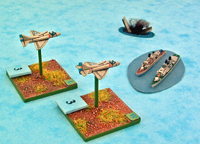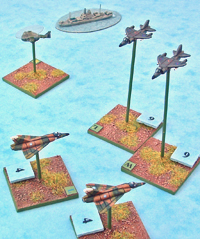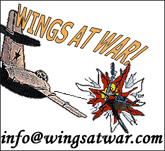Falklands
![]()
The occupation force incorporated a sizeable air warfare component including helicopters, a couple of
 dozen of the
indigenously designed twin-propeller Pucara light attack plane,
a half dozen MB.399 jet trainers (the heaviest jet that could operate
from the Island's short rough and ready runways) an air-search radar
with associated surface-to-air missiles and light anti-aircraft
guns. These were mainly based at Port Stanley, with a few Pucaras
and helicopters scattered at smaller airfields elsewhere.
dozen of the
indigenously designed twin-propeller Pucara light attack plane,
a half dozen MB.399 jet trainers (the heaviest jet that could operate
from the Island's short rough and ready runways) an air-search radar
with associated surface-to-air missiles and light anti-aircraft
guns. These were mainly based at Port Stanley, with a few Pucaras
and helicopters scattered at smaller airfields elsewhere.The Argentinian air arm was one of the strongest in South America. The Fuerza Aerea Argentina (FAA) and Comando de Aviacion Naval Argentina (CANA) was headed by eleven Mirage IIIE fighters, forty-six A-4 Skyhawks, six Canberra light bombers, thirty-four Daggers and five of the newly acquired Super Etendards. The later were the only planes capable of launching Argentina's collection of five AM.39 Exocet air-to-surface missiles.Task Force
The junta had completely misjudged their opponents. Though the Falklands no longer had any strategic or economic value the British could never countenance giving up sovereignty to a foreign invader. A task force was extemporised from whatever was available. Destroyers and frigates on exercise in the Mediterranean immediately set sail for the South Atlantic and linked up with a larger force from Britain that included the two carriers, the assault ship HMS Fearless and several landing ships. The cruise liners Queen Elizabeth and Canberra were requisitioned by the Navy, and along with the landing ships were loaded with troops, equipment and supplies and headed for Ascension Island in the middle of the Atlantic. Onboard the carriers were twenty of the Royal Navy's twenty-eight Sea Harriers. Hermes, the older of the carriers, added a contingent of RAF Harriers and was designated flagship.
It was a tremendous risk. Not since the Second World War had carriers been sent to operate in an area in which they could not guarantee air supremacy. With neither side able to back down the British made the first move of Operation Corporate on May Day with an attack by a single Vulcan bomber. Flying out of Ascension meant that the Vulcan had to perform a staggering eighteen in-flight refueling actions (requiring a total of fifteen Victor tanker sorties) for the long run south and back. As with all of the Vulcan bombing raids this first was not an unqualified success. Out of twenty-one bombs dropped just one managed to clip the edge of the runway. However, the attack was a jolt to the island's garrison and it also showed that Argentina itself was vulnerable to attack forcing the FAA to hold back significant numbers of Mirage fighters, the most advanced in their inventory, to defend the homeland. The sinking of the Argentine cruiser Belgrano, a World War Two vintage ship of dubious value, on the following day was another psychological blow which led to the bulk of the Argentinian navy, including the carrier Veinticinco de Mayo, spending most of the war in port.
On the same day as the first Vulcan raid the Royal Navy risked approaching to within a hundred miles of the Falklands. Six Sea Harriers provided a combat air patrol over the Task Force whilst twelve attacked Port Stanley and Goose Green airfields, a Harrier managing to destroy a Pucara as it was preparing to take off. Royal Navy ships conducted a series of shore bombardments of various military targets. Argentinian aircraft soon responded. There was always at least one pair of Sea Harriers on standing patrol and these soon found themselves defending against increasingly aggressive Argentinian incursions from the west. Sea Harriers destroyed a Mirage, a Dagger and a Canberra that first day for no loss to themselves. A further damaged Mirage was shot down by jumpy Argentinian AA gunners when it tried to make an emergency landing at Port Stanley. Argentinian pilots soon came to realize that the Harrier's all-aspect AIM-9L Sidewinder completely outclassed their own early generation rear-aspect air-to-air missiles.
Three days later the first Sea Harrier was lost to anti-aircraft fire whilst trying to take out Pucaras on the ground. That same morning Argentina's most potent weapon struck for the first time. Two Super Etendards, each armed with a single Exocet missile, used in-flight refueling to make the long journey
 to the point where reconnaissance had detected one large and two
smaller enemy ships. The Exocet is a potent anti-ship missile that
flies near the speed of sound at wave-top level and uses its own
onboard radar to home in on the target.
to the point where reconnaissance had detected one large and two
smaller enemy ships. The Exocet is a potent anti-ship missile that
flies near the speed of sound at wave-top level and uses its own
onboard radar to home in on the target.The Super Etendards approached very low to avoid being detected by ships radar and at around thirty miles from their targets popped up briefly to get a fix using their own nose-mounted radar. The missiles were launched shortly after and the aircraft turned for home. One Exocet missed its intended target, the frigate Yarmouth, but the other slammed into the destroyer Sheffield. Though the warhead didn't explode, unspent fuel started a raging fire that completely burnt out the ship. It was a spectacular success, though the Argentinians now only had three Exocets left. The Task Force withdraw further to the east thus seriously impeding air operations by increasing the range at which the Harriers had to operate.
Another destroyer was damaged later on by more conventional means whilst it was firing at shore targets. Two waves each of four Skyhawks took on Glasgow and Brilliant, and though three attackers were lost to surface-to-air missiles a single bomb went right through Glasgow causing extensive damage before exploding in the sea. One of the Skyhawks was shot down by 'friendly' AA fire on its way home. By then four Sea Harriers had been lost including two that disappeared in appalling weather, presumed victims of a mid-air collision. These were more than made up by the arrival of Sea Harriers and RAF GR.Mk3s transferred to the two carriers from the newly arrived container ship Atlantic Conveyor.
San Carlos
On the 21st May the British Task Force sailed into San Carlos Water on the West coast of East Falklands and began to unload troops. A defensive perimeter was set up on the high ground surrounding the inlet, including batteries of medium range SAMs. These forced the fierce but uncoordinated Argentinian air attacks to be made from very low level and soon San Carlos Water was swarming with bomb-laden Daggers, Sky Hawks and Falklands-based Pucaras and MB.339s. In all twelve attackers were shot down. British casualties were relatively light, an RAF Harrier had a wing shot off by AA fire as it attacked helicopters parked near Port Stanley and a couple of helicopters were lost. The frigate Ardent was sunk by seven bomb hits and many ships were damaged, but 3000 men and 1000 tons of supply were soon ashore, thus more or less guaranteeing ultimate victory to the British.
The following days provided periods of calm due to bad weather, interspersed with intense attacks by the Argentinians. Nineteen of their aircraft were shot down, mainly by Navy SAMs, but a destroyer and two frigates were sunk and several ships damaged. Another raid by a pair of Exocet-armed Super Etendards accounted for the Atlantic Conveyor whose radar profile was similar to that of a carrier. Her cargo of Harriers had already left but all but one of the Chinook helicopters onboard went down with the ship. Another RAF Harrier was destroyed by AA fire whilst supporting an attack on Goose Green, the Argentinians throwing in Pucaras to support the defenders.
The last of the air-launched Exocets was fired during this period. This time the ships on picket duty detected the Super Etendard's radar and the whole Task Force fired off chaff to successfully decoy the
 missile.
To avoid the trek across East Falklands the British decided to take
a risk and use two landing ships to ferry men of the Welsh Guards
round the south of the island to Bluff Cove preparatory to the final
assault on the capital. This move was soon detected by Argentinian
shore observers. In the hope of drawing off the Sea Harriers the
Argentinans made a diversionary raid on San Carlos by four Mirage
fighters. On the way in, the Skyhawks and Daggers of the main force
attacked and hit HMS Plymouth before swooping on the landing ships
in Bluff Cove. Both were badly damaged and fifty-one men killed.
missile.
To avoid the trek across East Falklands the British decided to take
a risk and use two landing ships to ferry men of the Welsh Guards
round the south of the island to Bluff Cove preparatory to the final
assault on the capital. This move was soon detected by Argentinian
shore observers. In the hope of drawing off the Sea Harriers the
Argentinans made a diversionary raid on San Carlos by four Mirage
fighters. On the way in, the Skyhawks and Daggers of the main force
attacked and hit HMS Plymouth before swooping on the landing ships
in Bluff Cove. Both were badly damaged and fifty-one men killed.Port Stanley
The ground war intensified the nearer the British got to Stanley and both sides used aircraft to target enemy ground positions. British missile-armed helicopters joined RAF Harriers and the Argentinians lost a Canberra to ground fire but managed to attack the enemy Brigade HQ with their Skyhawks. Harrier missions were running at the tremendous rate of up to ten sorties per plane and four sorties per pilot per day.By the 14th June Port Stanley was surrounded. The Argentinian garrison was in a hopeless position and had no option but to surrender. It had been a close run thing. The British carriers and troop ships had proved to be extremely vulnerable to Exocet attack and it was fortunate that the enemy had so few. Argentina had lost over one hundred aircraft, thirty-six in combat, a loss rate comparable to the most intense aerial battles of World War Two. Seven British ships were sunk, three RAF Harriers and six Sea Harriers lost to ground fire or accidents.
Click on the links below for more information
